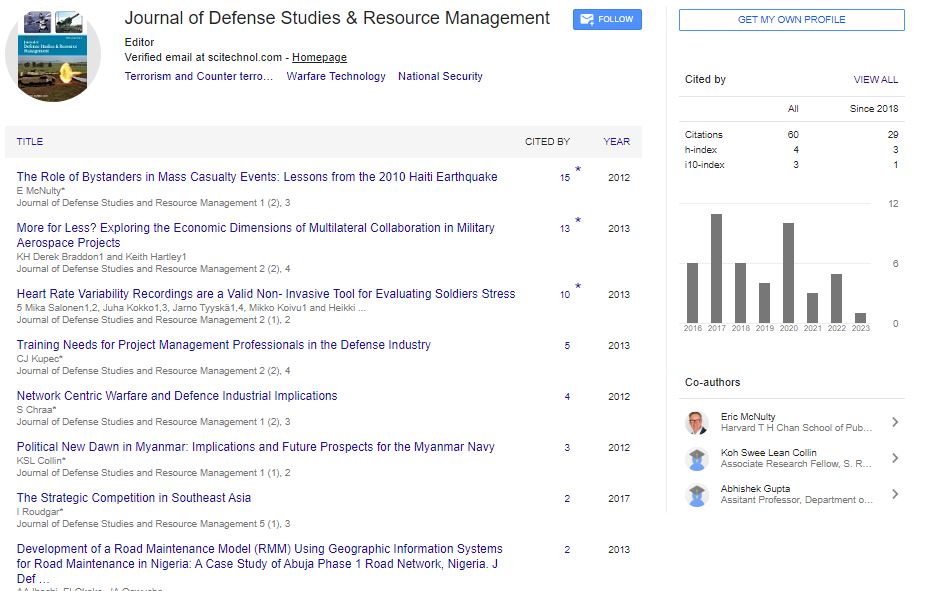Perspective, J Def Stud Resour Manage Vol: 11 Issue: 4
Exploring the Dynamics of Global Stability through Arms Control and Global Disarmament
Mroz Scahlnhauf*
1Department of Economics, University of Lausanne, Lausanne, Switzerland
*Corresponding Author: Mroz Scahlnhauf,
Department of Economics, University
of Lausanne, Lausanne, Switzerland
E-mail: mroz2@uzh.ch
Received date: 30 October, 2023, Manuscript No. JDSRM-23-123194;
Editor assigned date: 01 November, 2023, PreQC No. JDSRM-23-123194 (PQ);
Reviewed date: 16 November, 2023, QC No. JDSRM-23-123194;
Revised date: 23 November, 2023, Manuscript No. JDSRM-23-123194 (R);
Published date: 30 November, 2023, DOI: 10.4172/ 2324-9315. 1000197
Citation: Scahlnhauf M (2023) Exploring the Dynamics of Global Stability through Arms Control and Global Disarmament. J Def Stud Resour Manage 11:4.
Abstract
In a world often overshadowed by geopolitical tensions and the spectra of armed conflicts, the concepts of arms control and disarmament emerge as beacons of hope for fostering international stability and security. These interconnected strategies aim to limit the proliferation of weaponry, mitigate the risks of conflict, and pave the way for a more peaceful coexistence among nations. It Involves agreements and arrangements that seek to limit or regulate the quantity, type, and deployment of weapons.
Description
In a world often overshadowed by geopolitical tensions and the spectra of armed conflicts, the concepts of arms control and disarmament emerge as beacons of hope for fostering international stability and security. These interconnected strategies aim to limit the proliferation of weaponry, mitigate the risks of conflict, and pave the way for a more peaceful coexistence among nations. It Involves agreements and arrangements that seek to limit or regulate the quantity, type, and deployment of weapons. The objective is to establish frameworks that prevent the escalation of arms races and contribute to strategic stability. It encompasses the reduction or elimination of existing military capabilities, including weapons and armed forces. Disarmament efforts strive to create a world with fewer weapons, reducing the potential for conflict and minimizing the impact of warfare.
Historical context
The roots of arms control and disarmament initiatives can be traced back to the aftermath of World War I, with the League of Nations attempting to address the dangers of unrestrained militarization. However, it was after World War II that the international community, recognizing the devastating consequences of modern warfare, intensified efforts to control and reduce arms. Key milestones in this journey include the Treaty on the Non-Proliferation of Nuclear Weapons (NPT) in 1968, aimed at preventing the spread of nuclear weapons; the Strategic Arms Limitation Talks (SALT) between the United States and the Soviet Union during the Cold War; and the Chemical Weapons Convention (CWC) and the Biological Weapons Convention (BWC), both aimed at prohibiting the development and use of certain types of weapons.
Verification and Compliance should ensure that nations adhere to agreed-upon arms control measures requires robust verification mechanisms. Trust-building measures and transparency are essential for maintaining the effectiveness of these agreements. Global power dynamics and geopolitical rivalries can impede progress in disarmament efforts. The reluctance of major powers to relinquish their strategic advantages poses a significant obstacle. The rapid advancement of technology, including cyber capabilities and autonomous weapons, presents new challenges for arms control. The frameworks developed for traditional weapons may struggle to keep pace with evolving technologies. Nations often face security dilemmas, where concerns about the intentions of other states drive military build-ups for defensive purposes. Breaking this cycle requires addressing the root causes of distrust and insecurity.
Conclusion
In conclusion, arms control and disarmament represent humanity's collective effort to mitigate the destructive potential of armed conflict. By fostering cooperation, building trust, and addressing the root causes of insecurity, the international community can pave the way for a future where the threats posed by excessive weaponry are significantly diminished. The journey toward global security requires sustained commitment, innovative solutions, and a shared vision of a world free from the shadow of unbridled militarization.
 Spanish
Spanish  Chinese
Chinese  Russian
Russian  German
German  French
French  Japanese
Japanese  Portuguese
Portuguese  Hindi
Hindi 